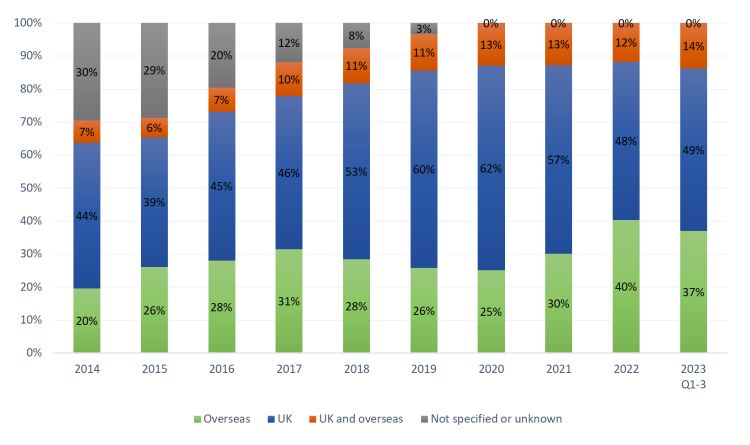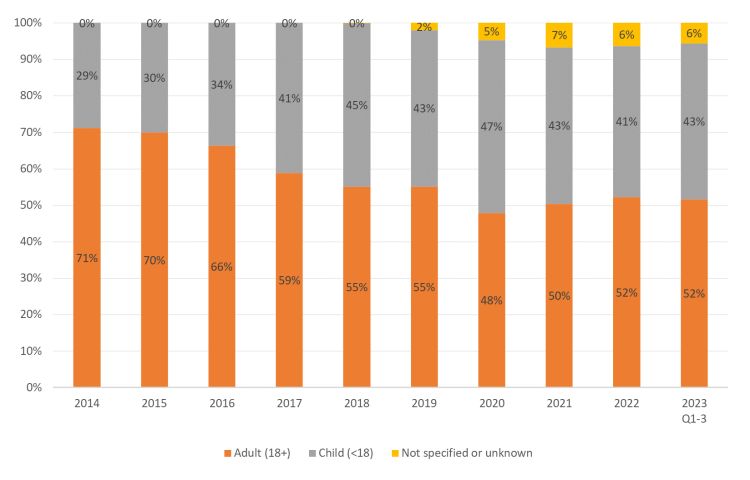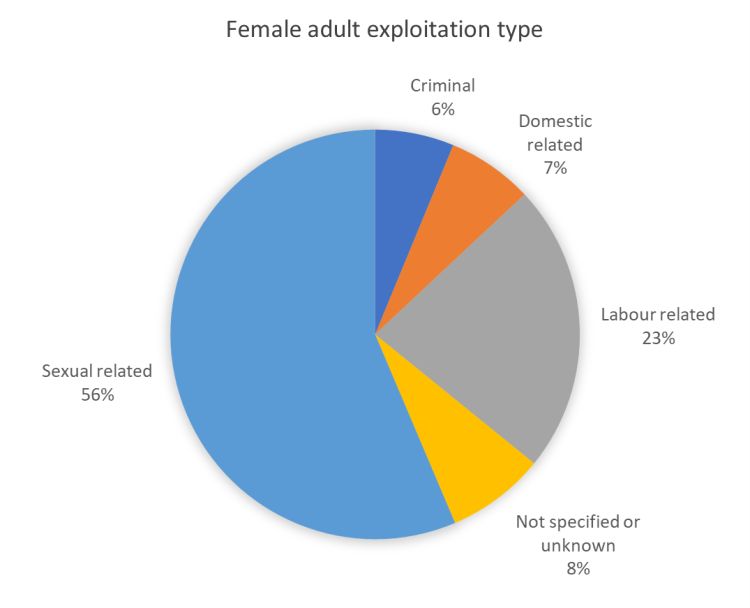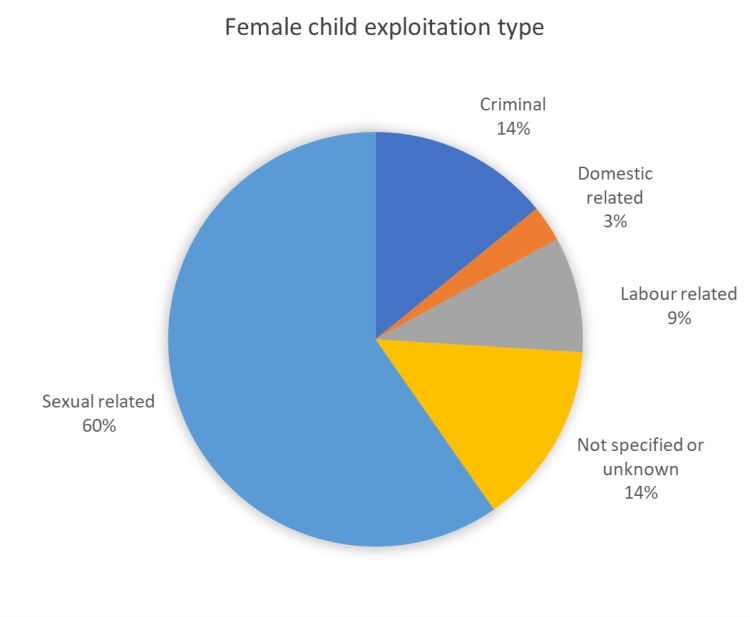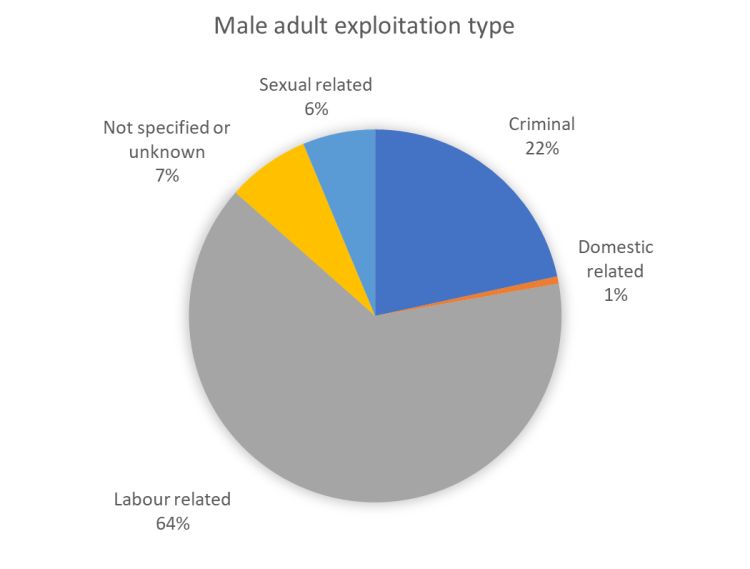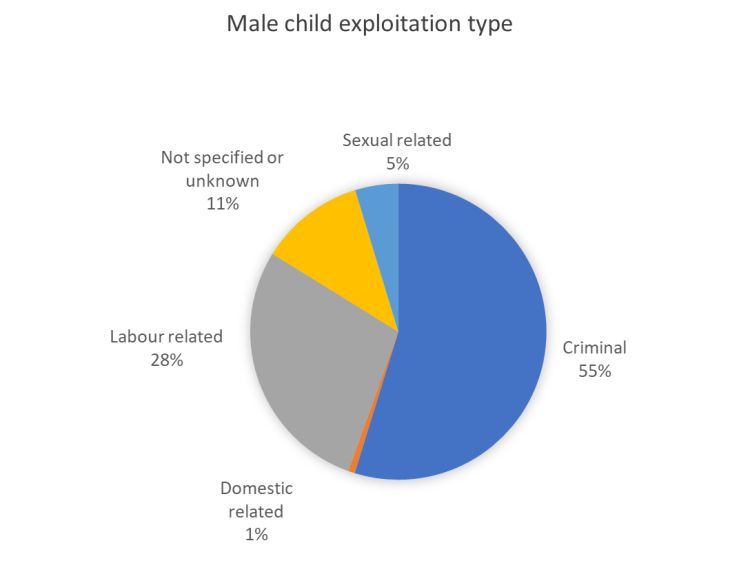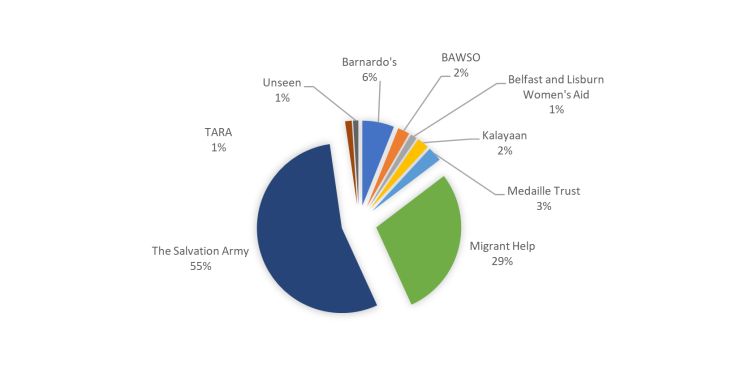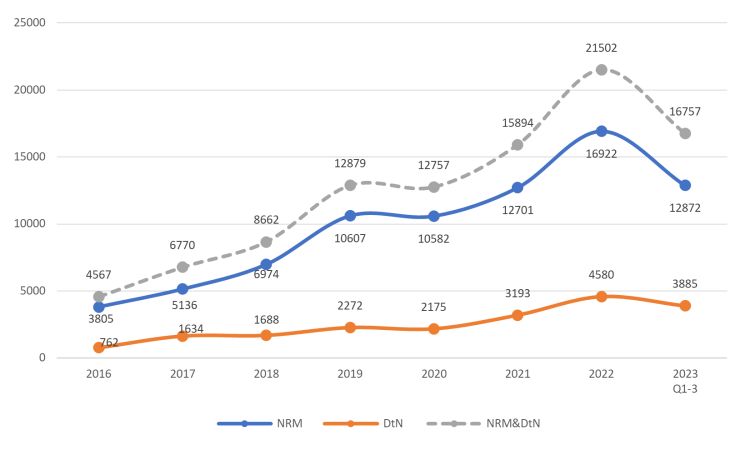An update on Modern Slavery trends in the UK: analyses of UK National Referral Mechanism (NRM) statistics
- Centre for Operations and Supply Chain Research

The Global Slavery Index 2023 estimated that around 122,000 people are in situations of modern slavery (where an individual is exploited by others for personal or commercial gain) in the UK. Figures are estimated rather than definitive given that not all modern slavery cases are reported. However, official data are entered when first responders (people with specialized training who are among the first to arrive and provide support at the scene of an emergency) file a referral to a competent authority within the Home Office through the National Referral Mechanism (NRM).
The NRM is a framework for referring and identifying potential victims of modern slavery in the UK to ensure them the appropriate support. Potential victims are required to be referred to the police by first responders or the relevant competent authorities.
Since the enactment of the UK Modern Slavery Act in 2015, stakeholders, including the public, investors, businesses, and NGOs, have shown a growing interest in understanding the landscape of potential modern slavery victims in the UK. (Recognising that not every individual in the data is a confirmed victim of modern slavery, we use the phrase “potential victims” throughout this blog post.)
This blog post analyzes official NRM statistics from 2020 to September 2023, shedding light on concerning trends related to the nature of exploitation, demographics, nationality, and more. This analysis is crucial for investors and businesses aiming to fulfil their responsibilities in addressing modern slavery risks within their operations. As modern slavery remains a complex and often hidden crime, this data analysis seeks to provide stakeholders with a clearer picture of trends, enabling them to prioritize effective risk management strategies.
During these years, where did slavery exploitation take place?
Trend 1. Exploitation took place inside and outside the UK, while overseas exploitation was rising. Figure 1 shows there were high percentages of un-specified locations of exploitation in the early years since NRM data were first collected in 2014, but it has dropped to zero since 2020 due to an improvement in the data collection process, meaning data after 2020 are more accurate.
The figure shows that most referrals (around 40-60%) experienced exploitation in the UK only. In the early years (2014 - 2017), about 10% of potential victims were exploited both in the UK and overseas, while the number has gone up to about 13%. Overseas-only exploitation ranged from 20-30% between 2014 and 2021, but it reached its highest number (6,827) and proportion of all referrals (40%) in 2022. When more than one third of the NRM cases involved exploitation outside of the UK, the investigation becomes more complex and difficult.
Figure 1. Percentage of NRM referrals by location of exploitation
How do patterns of exploitation vary across gender and age?
Trend 2. The ratio has changed from every two adults to one child, to almost one adult to one child. We also analyzed demographic data of the potential modern slavery victims. The adult-child ratio in the past was much larger and has been decreasing. For every one child (672), there were more than two adults (1,665) in 2014. There were one-third (1,281) children and two-thirds (2,524) adults in 2016. Of the potential victims referred since 2020, around 48-52% were adults, whilst 41-47% were children. Not only has the number of children potential victims increased, but the adult-child ratio has dropped to almost one-to-one.
Figure 2. Percentage of NRM referrals by age at exploitation
Trend 3. For UK-only exploitation, the number and proportion of children is higher than that of adults. We managed to segment the UK-only exploitation into adults and children and revealed a shocking trend. From 2020, around 40-50% adults (2,544 in 2020; 3,078 in 2021; 3,424 in 2022) experienced exploitation in the UK-only, whilst about 65-75% children (3,823 in 2020; 3,901 in 2021; 4,394 in 2022) claimed they experienced exploitation in the UK.
Trend 4. The female-male ratio is about one to three. Out of the referrals made to the Home Office since 2020, about 21-26% were female (2,752 in 2020; 2,923 in 2021; 3,634 in 2022) and 74-78% male (7,826 in 2020; 9,790 in 2021; 13,290 in 2022).
Trend 5. Female adult and child victims mostly experienced sexual exploitation. Figure 3 shows the average proportions of exploitation type since 2020. For female adult victims, sexual-related exploitation was the most common (56%), followed by labour-related exploitations (23%), domestic (7%) and criminal exploitation (6%). Sexual exploitation is worst in female child group (60%), as well as in the criminal category (14%).
(Sexual exploitation is “any abuse of vulnerability for sexual purposes”; labour exploitation refers to “situations in which a person is coerced to work through the use of violence and/or psychological intimidation”; criminal exploitation “is where a person is forced into criminal activity for another’s gain” eg drug dealing, benefit fraud, theft, the selling of counterfeit goods; domestic exploitation is “where domestic workers – often maids, housekeepers, cleaners, nannies, or those caring for the elderly, ill and infirm – are forced to work for little or no pay, with restricted freedom”. Modern Slavery Handbook, The Passage.)
Figure 3. Percentage of female NRM referrals by exploitation type in different age groups, 2020-2023Q3
Trend 6. More labour exploitation for male adults, more criminal exploitation for male children. Figure 4 compares the exploitation types between male adults with male children since 2020. Labour-related exploitation was most reported in adults and in the unknown age group (62-64% in 2020-2023). Criminal exploitation follows behind with 22%. This is the opposite for children, where criminal exploitation was most referred (55%) followed by labour-related exploitation (28%). While child criminal exploitation in the UK cannot be ignored, forcing them to work is also a serious crime.
Figure 4. Percentage of male NRM referrals by exploitation type in different age groups, 2020-2023Q3
Where do the victims come from?
Trend 7. From the referrals made within the UK during this time, around half were UK and Albania nationals. 25-34% were UK nationals and 17-27% were Albanian. UK nationals accounted for 34% (3,560) in 2020 and 31% (3,952) in 2021. In 2022, Albanian potential victims overtook UK nationals and contributed to 27% (4,613) of all referrals.
Trend 8. Many other nationalities are involved. The UK has attracted irregular immigrants (migrants who enter or remain in a country without proper authority) from all over the world, which makes modern slavery a global issue. Of all referrals, Vietnamese comprised 5-8%, Sudanese accounted for 4-6%; Eritrean was 3-7%; Romanian and Iranian contributed 2-3% respectively; Chinese ranged from 1-3%; Iraqi, Indian, Nigerian, Afghan and Somali each made up 1-2%; Pakistani, Ethiopian, Syrian and Polish each constituted 1%.
Trend 9.There are unique exploitation types for some nationalities. Among the top-20 nationalities of potential modern slavery victims each year, labour-related exploitations were predominant ranging from 34-88%, except for UK nationals, Nigerian, Brazilian (in 2023) and Ghanaian (in 2020). The proportion of criminal exploitation was always the highest for UK nationals (67-68%), while Nigerian were among the most referred nationalities for sexual-related exploitations (34-40%).
The second most common exploitation for Romanian, Iranian and Chinese referrals was sexual-related exploitations. For Filipino and Pakistani, it was domestic-related exploitation; while for Polish, it was criminal exploitation.
Identifying potential victims not only requires people with different language skills, but also knowledge and experience about the different types of exploitation.
Which first responders made the most referrals?
Trend 10. Home Office-UK Visas and Immigration (UKVI) referred the most as a first responder. The proportion of all referrals has increased from 32% (3,401) in 2020 to 49% (8,338) in 2022. Government agencies referred the most potential modern slavery victims. Of this, Home Office-Immigration Enforcement IE accounted for about 14-20%, Home Office-UK Visas and Immigration UKVI contributed 16% (1,743) in 2020, 22% (2,755) in 2021, 28% (4,739) in 2022.
Trend 11. Police as first responders handle the second most referrals, and the number is declining. Police forces made the second most referrals, but its percentage has declined year by year, which was 32% (3,431) in 2020, 30% (3,843) in 2021, 23% (3,887) in 2022, and 23% (2,951 till September) in 2023.
Trend 12. NGOs accounted for around 5-8% of NRM referrals, and the proportion of local authority referrals was around 22-28%. Local authorities covered half of all child referrals, and its number of child referrals were ten times higher than that of adult referrals (2,653 vs 216 in 2020; 2,900 vs 275 in 2021; 3,386 vs 238 in 2022; 2,680 vs 214 in 2023 till September), while other first responders referred more adults than children.
Of all NGO referrals from 2020, on average, The Salvation Army made 55% referrals, Migrant Help referred 29%, Barnardo’s contributed 6%, Medailee Trust accounted for 3%, Kalayaan and BAWSO each sent 2%, TARA and Unseen each constituted 1%, Belfast and Lisburn Women’s Aid provided 1% as well.
Figure 5. Average percentage of NGO first responders, 2020-2023Q3
Duty to Notify (DtN) referrals
The NRM statistics only cover referred cases. There are potential adult victims who refused to be referred. Specific public authorities in England and Wales are obliged to notify the Home Office via the DtN process from 1 November 2015 if adult potential victims do not consent to enter the NRM. NRM referral is specifically used to refer to adult potential victims who have given consent and child potential victims who need not consent to enter.
Trend 13. The number of DtN referrals has increased since 2016, from 762 in 2016 to 4,580 in 2022. Since 2020, the most referred nationalities were Eritrean 6-20%, Albanian 14-17%, UK 7-12%, Sudanese 7-12%, Romanian 6-15%, Chinese 5-11%, Vietnamese 4-8%. Overall, labour-related exploitation was the most referred (44-49%) followed by sexual-related exploitation (18-26%) and criminal-only exploitation (11-15%).
Similar to NRM referrals, the Home Office-UKVI referred the most potential victims as a first responder, which was 37% (796) in 2020, 45% (1,431) in 2021, 57% (2,624) in 2022, and 57% (2,214) in 2023 (as of September).
Figure 6. The number of NRM and DtN referrals, 2016-2023Q3
Concluding remark and future research
This blog highlights some concerns related to the potential victims of modern slavery in the UK. First, the number of child victims has increased; more children experienced UK-only exploitation than adults. Second, it is not just irregular migrants who are potential victims of modern slavery; about a quarter/up to a third of the potential victims are UK nationals. The main exploitation they experienced was criminal. Third, the DtN data show about 25% more potential victims in addition to the NRM data. This, however, is just the tip of the iceberg as many victims are hidden and have not been discovered by the current systems.
To continue informing the public and policy, the research team will continue analyzing the latest NRM data. We welcome NGOs and first responders to collaborate with the project with the goal of mapping complete modern slavery supply chains.
Contact us
If you would like to get in touch regarding any of these blog entries, or are interested in contributing to the blog, please contact:
Email: research.lubs@leeds.ac.ukPhone: +44 (0)113 343 8754
Click here to view our privacy statement. You can repost this blog article, following the terms listed under the Creative Commons Attribution-NonCommercial-NoDerivatives 4.0 International licence.
The views expressed in this article are those of the author and may not reflect the views of Leeds University Business School or the University of Leeds.


